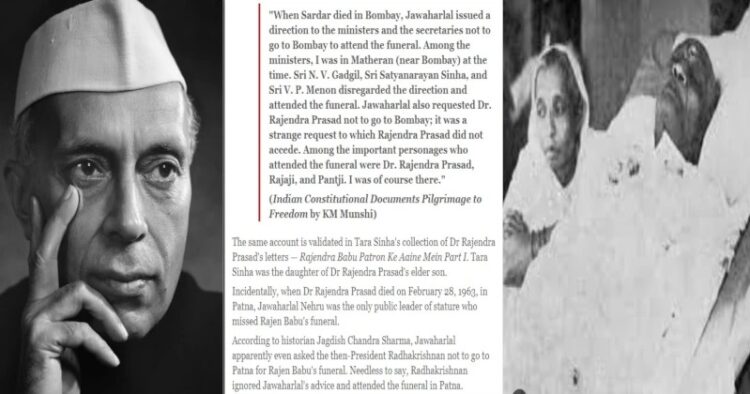The nation mourned as news of the sudden demise of Sardar Vallabhbhai Patel, often referred to as India’s Iron Man, reverberated across the country. Patel, renowned for overseeing the unification of over 500 princely states into the Republic of India, passed away in Mumbai due to a massive heart attack. Despite his critical role in shaping post-colonial India, the circumstances surrounding his funeral became a historical footnote.
The directive allegedly issued by Prime Minister Jawaharlal Nehru, instructing his cabinet colleagues not to attend Sardar Patel’s funeral, added a controversial layer to the grieving process. Sardar Patel, who had been ailing, had heeded advice to take a break and was recuperating in Mumbai’s Birla House since December 12.
Kanhaiyalal Maneklal Munshi, also known as KM Munshi, a key figure in the Constituent Assembly and the Governor of Uttar Pradesh from 1952-57, revealed this aspect in his book “Pilgrimage to Freedom.” Munshi highlighted Nehru’s reported directive to ministers and secretaries, urging them to refrain from attending the funeral. However, some, including NV Gadgil, Satyanarayan Sinha, and VP Menon, chose to disregard the directive and attended the last rites.
References for 1 and 2
1. Pilgrimage to Freedom, by KM Munshi
2. Rajendra Babu Patron Ke Aaine Mein Part I, Tara Sinhaas reproduced in https://t.co/AjGK0cfGem pic.twitter.com/uvWhf3ZQ8T
— Abhinav Agarwal (@AbhinavAgarwal) June 11, 2021
Among those who attended despite Nehru’s alleged request were prominent figures such as Dr. Rajendra Prasad, Rajaji, and Pantji. Munshi himself was present at the funeral, defying the directive.
Incidentally, historical accounts reveal a similar situation during the funeral of Dr. Rajendra Prasad on February 28, 1963. At that time, Nehru was the sole prominent public leader who reportedly missed Rajendra Prasad’s last rites. According to historian Jagdish Chandra Sharma, Nehru even advised then-President Radhakrishnan against attending the funeral in Patna. However, Radhakrishnan chose to overlook Nehru’s suggestion and paid his respects in Patna.
Turning the focus to Sardar Vallabhbhai Patel’s illustrious life, he emerged as a founding father of the Republic of India and one of the key figures behind the Indian National Congress. A social leader, barrister, and staunch freedom fighter, Patel played a pivotal role in directing the country’s independence war and unifying it into a single, sovereign nation.
Hailing from the Gujarat countryside, Patel initially thrived as a lawyer, establishing a successful practice. His foray into politics saw him rallying peasants in Gujarat against the British Raj’s oppressive laws, solidifying his status as one of the state’s most influential leaders.
Ascending to the top of the Indian National Congress, Patel led the party through rebellions, organised elections in 1934 and 1937, and actively pushed the Quit India movement. As India gained independence on August 15, 1947, Patel assumed the role of the country’s first Deputy Prime Minister, with Nehru becoming the first Prime Minister. Patel also oversaw the Ministry of States, Home Affairs, and Information and Broadcasting.
Tasked with uniting India, Patel faced the monumental challenge of integrating the British colonial provinces and more than 500 self-governing princely states liberated during the Indian Independence Movement. Recognising the importance of national unity, he fervently pleaded with officials to keep the country united.
Dr Rajendra Prasad, in acknowledgment of Patel’s contributions, stated in his journal on May 13, 1959, “It is primarily due to Sardar Patel’s statesmanship and harsh administration that there is now an India to think about and write about.” Patel’s foresight was evident in a letter to Nehru on November 7, 1950, where he expressed skepticism about China, a caution that materialised in the Sino-Indian conflict twelve years after Patel’s passing.
Sardar Vallabhbhai Patel, the General of Bardoli, Gujarat’s Lion, India’s Man of Steel, breathed his last in December 1950 at the age of 75. Remembered as the “Patron Saint” of India’s public workers for developing modern all-India Administrative Services, he is also celebrated as the “Iron Man of India” and the “Indian Bismarck.” His enduring legacy continues to inspire generations, shaping the narrative of a unified and modern India.



















Comments